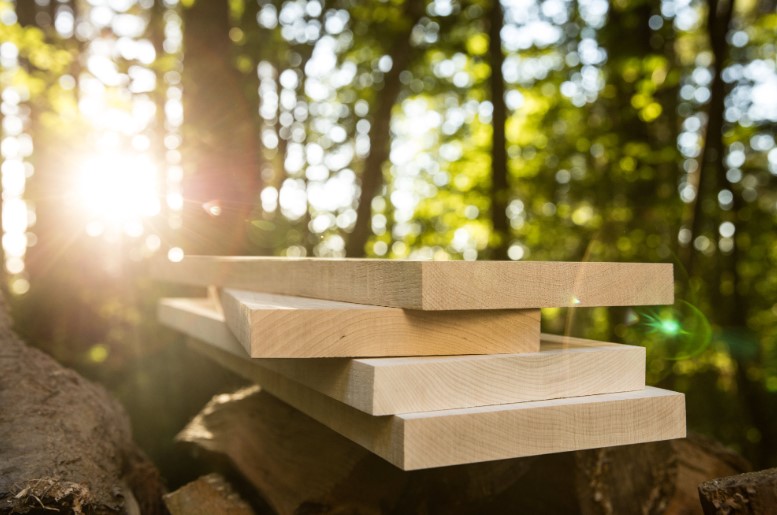The Essential Guide to Understanding Lumber and Plywood

When it comes to building materials, few are more ubiquitous than lumber and plywood. These two materials can be found in homes, offices, and construction sites all over the world. But what exactly are lumber and plywood, and why are they so important?
Lumber is a type of wood that has been cut and processed for use in construction. It comes in a variety of shapes and sizes, and can be made from a range of different tree species. Plywood, on the other hand, is made by gluing together thin layers of wood veneer, with the grains of each layer running perpendicular to the previous layer. This gives plywood its characteristic strength and durability.
In this blog post, we’ll take a closer look at lumber & plywood, exploring what they are, how they’re made, and what they’re used for. We’ll also delve into the key differences between these two materials, and provide tips for choosing the right material for your next building project. Whether you’re a DIY enthusiast or a professional contractor, understanding the ins and outs of lumber and plywood can help you to create stronger, more durable, and more beautiful buildings.
What is Lumber?
Common Types Of Lumber
Lumber is a type of wood that has been cut and processed for use in construction. It is typically made from trees that have been harvested from managed forests, and it comes in a variety of shapes and sizes. Common types of lumber include softwood, hardwood, and engineered wood products.
Softwood Lumber
Softwood lumber is the most commonly used type of lumber, and it is made from trees like pine, spruce, and fir. Softwood lumber is relatively inexpensive and easy to work with, and it is used in a wide range of applications, from framing to decking.
Hardwood Lumber
Hardwood lumber, as the name suggests, is made from hardwood trees like oak, maple, and cherry. Hardwood lumber is more expensive than softwood lumber, but it is also stronger and more durable. Hardwood lumber is often used for flooring, cabinetry, and furniture.
Engineered Wood Products
Engineered wood products, such as plywood and oriented strand board (OSB), are made by gluing together wood fibers or veneers. These products are often used in place of solid wood because they are more affordable and can be made to be stronger and more durable than natural wood.
Regardless of the type of lumber, it is an incredibly versatile building material that can be used in a wide range of applications. From framing to finishing, lumber plays a critical role in the construction of homes, offices, and other structures.
What is Plywood?
Plywood is a type of engineered wood product that is made by gluing together thin layers of wood veneer, with the grains of each layer running perpendicular to the previous layer. This cross-grain construction gives plywood its characteristic strength and durability, making it an ideal material for a wide range of construction applications.
Plywood is typically made from softwood species like pine, spruce, or fir, although it can also be made from hardwood species like oak or maple. The veneers used to make plywood are typically peeled from logs using a rotary lathe, which produces a continuous ribbon of veneer that can be cut into sheets.
Once the veneers are cut, they are dried and sorted based on their quality. The veneers are then glued together using a variety of adhesives, such as phenol formaldehyde, urea formaldehyde, or melamine formaldehyde. These adhesives are designed to be strong and durable, and they are able to bond the veneers together in a way that creates a single, solid panel.
Plywood is often used in construction applications where strength and durability are important. It can be used for everything from sheathing and subflooring to roofing and exterior siding. Plywood is also commonly used in furniture, cabinetry, and decorative applications, where its smooth, consistent surface is ideal for painting, staining, or laminating.
Key Differences Between Lumber and Plywood
While lumber and plywood are both made from wood, there are some key differences between these two materials that make them suited for different applications. Here are a few of the most important differences:
- Construction: Lumber is typically made from solid pieces of wood that are cut and shaped to size. Plywood, on the other hand, is made by gluing together thin layers of wood veneer.
- Strength: Lumber is generally stronger and more durable than plywood, especially in applications where weight-bearing capacity is important. However, plywood can be engineered to be quite strong, and its cross-grain construction gives it excellent strength and stiffness for its weight.
- Cost: Lumber is typically less expensive than plywood, although this can vary depending on the specific type of wood and the application.
- Appearance: Lumber has a more natural and rustic appearance, with visible grain patterns and knots. Plywood has a smoother, more consistent surface that is ideal for painting, staining, or laminating.
- Versatility: While lumber is generally best suited for structural applications like framing and decking, plywood can be used in a wide range of applications, from sheathing and subflooring to furniture and cabinetry.
Overall, the choice between lumber and plywood will depend on the specific needs of the project. In general, lumber is better suited for heavy-duty structural applications, while plywood is more versatile and can be used in a wider range of applications.
Best Uses for Lumber and Plywood
While lumber and plywood have some overlap in their applications, there are certain projects where one material is clearly superior to the other. Here are some of the best uses for lumber and plywood:
1. Best Uses for Lumber:
- Framing: Lumber is ideal for structural framing, such as wall studs and roof rafters, as it provides excellent strength and stability.
- Decking: Lumber is a popular choice for building decks, as it is durable and can withstand exposure to the elements.
- Fencing: Lumber is also a common choice for building fences, as it provides a natural and rustic appearance.
2. Best Uses for Plywood:
- Sheathing and Subflooring: Plywood is often used as sheathing and subflooring for buildings, as it provides excellent strength and stability.
- Cabinetry and Furniture: Plywood is a popular choice for building cabinetry and furniture, as it can be laminated with various finishes and provides a smooth, consistent surface.
- Decorative Projects: Plywood can also be used for decorative projects, such as wall paneling and decorative shelving.
The best use for lumber and plywood will depend on the specific needs of the project. Consider the application, required strength, and desired appearance when deciding which material to use.
How to Choose the Right Lumber or Plywood
Choosing the right lumber or plywood can be a daunting task, as there are many different types and grades available. Here are some key factors to consider when selecting the right material for your project:
- Application: Consider the intended use of the material. Will it be used for structural framing, decorative purposes, or something else?
- Species: Different species of wood have different properties, such as strength, durability, and appearance. Choose a species that is appropriate for your project.
- Grade: Lumber and plywood are graded based on their quality, with higher grades indicating fewer defects and better appearance. Consider the grade that is appropriate for your project and budget.
- Moisture Content: Wood is a natural material that expands and contracts with changes in moisture content. Make sure to choose lumber or plywood with an appropriate moisture content for your environment.
- Size: Consider the size and thickness of the material, as well as any special cuts or finishes that may be required for your project.
- Sustainability: If environmental sustainability is a concern, look for lumber and plywood that are certified by organizations such as the Forest Stewardship Council (FSC).
By considering these factors and doing your research, you can choose the right lumber or plywood for your project and ensure its success.
Conclusion
Lumber & plywood are versatile and essential building materials that are used in a wide variety of projects. They both have their unique advantages and disadvantages, and it’s important to understand the differences between them to choose the right material for your project.
When selecting lumber or plywood, consider factors such as the intended use, species, grade, moisture content, size, and sustainability. By doing your research and taking these factors into account, you can ensure that your project is successful and meets your needs.
Whether you’re a DIY enthusiast or a professional contractor, knowing how to choose and work with lumber & plywood is an important skill. With the right tools, techniques, and knowledge, you can create beautiful and functional projects that will stand the test of time.








